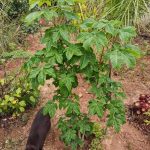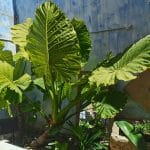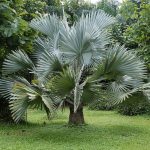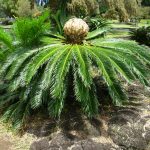
Large-leaved plants are what make a garden look tropical even though it is located thousands of kilometers from the tropics. Although they need some climatic stability, there are many varieties capable of withstanding cold and frost.
In fact, regardless of whether you are for example somewhere in the Mediterranean region or in an area with high altitude that is covered with snow when winter arrives, I encourage you to take a look at the selection of large leafy plants for outdoor that we recommend.
Aesculus hippocastanum (Horse chestnut)
- Copy of my collection.
El horse chestnut It is a deciduous tree that is not only large in itself (it can measure 30 meters high), but also has palmate leaves about 60 centimeters wide. It grows quite fast when it is young: mine has grown to two feet in a single year; As an adult, on the other hand, he slows down a bit.
It is an outdoor plant that gives a lot of shade, since it has a leafy and wide crown, and it produces very pretty white flowers in spring. It lives well in almost any type of soil; I can even affirm that it tolerates the clayey ones since mine grows in one, and I have never seen chlorotic leaves. It easily withstands frosts down to -20ºC.
Alocasia macrorrhizos (Elephant ear)
- Exemplary of a restaurant on the island of Mallorca (Spain).
- Image - Wikimedia / David J. Stang
La elephant ear It is a plant that is widely grown indoors, but what is perhaps unknown is that it can also be grown outdoors, in a protected area and as long as the weather is good, that is, it is warm. It grows more or less up to 2 meters in height, and develops leaves about 70 centimeters long by 40-50 centimeters wide.
It lives in shade or semi-shade, in places where there is a lot of light, and where the ambient humidity is high. If there is frost in your area, you can keep it outside during the spring and summer, and bring it indoors during the winter.
Now, if you have a patio with a roof, or an area very sheltered from the wind, and the frosts are weak (down to -2ºC), I encourage you to keep it outside. In these conditions they have a copy in Mallorca, and it is beautiful (you can see a photo of it above).
Bismarckia nobilis (Bismarck Palm)
- Image – Wikimedia/Vengolis // Bismarckia nobilis
- Image - Flickr / Forest and Kim Starr
Few palm trees have leaves as large as the Bismarckia nobilis. These They are fan-shaped, and can measure more than 3 meters in diameter when the plant is adult. Its trunk thickens up to 45 centimeters in diameter, and grows between 12 and 25 meters in height, depending on the climatic conditions (in hot climates it is usually taller than in cooler ones).
There are two varieties: the common one, which is the one with silver leaves, and the one with green leaves, known as Bismarckia nobilis 'Mayotte'. Both need the same: direct sun, water from time to time, and mild winters. They support up to -4ºC.
Cycas revoluta (cica)
- Image - Flickr / Dinesh Valke
- Image - Flickr / brewbooks
La cat It is a perennial and very resistant plant that reaches a maximum height of 7 meters. Its trunk, once it finishes growing, measures 20-25 centimeters thick, and of it sprout green, leathery leaves up to 150 centimeters long.
It is a primitive species, which has been on Earth for more than 200 million years. It is very adaptable, since it lives in tropical climates but also in temperate ones. It only needs a lot of light, or even direct sun, and to receive water from time to time. Resists up to -7ºC.
colocasia esculenta
- Image - Wikimedia / Dalgial
- Image - Flickr / Drew Avery // Colocasia esculenta »Black Magic»
La colocasia esculenta is a rhizomatous and perennial herbaceous plant that can measure up to 2 meters in height. In addition, there are many cultivars selected for the color of their leaves and petioles, such as:
- Black Magic: it has lilac leaves.
- Black Ripple: similar to the previous one, but of a darker color and with more pronounced nerves.
- Hawaiian Punch: it has green leaves, but red stems and veins.
- Jack's Giant Variegated: it is a cultivar that tends to produce green and white leaves in spring, and only green in summer.
- And of course there is the common variety, which has green leaves and stems.
Its leaves are not the largest, but they are perfect for tropicalizing a garden or patio: they measure between 30 and 40 centimeters long by 20-50 centimeters wide. And what do you need? Well, shade or semi-shade, high humidity, and frequent waterings. It is also important that you do not expose yourself to frost without protection, at least when young.
In some English portals, such as PlantdeLights.com, they say that it could hold in zone 8B, that is, down to -10ºC as long as it is protected. But me personally I recommend putting it at home if it drops below -4ºC, because if the leaves are damaged by hail, they will die with the snow. The rhizome does last longer, but if we want to have it beautiful all year round, it is preferable not to take risks.
Ensete ventricosum 'Maurelli'
- Copy of my collection
He has me in love Ensete ventricosum 'Maurelli'. It is native to tropical Africa, it is rhizomatous and has a trunk that, although it can reach 4 meters in height, remains relatively thin. Mine is an adult, and is about 40 inches thick. The leaves are whole, they can exceed 2 meters long and 50 centimeters wide, and they are reddish-green at first and totally green when they finish unfolding.
The downside is that his life is very short. After about 10 years of growth, it blooms, produces seeds, and finally dies. The good part is that they germinate soon if they are planted as soon as they mature and are provided with heat and light. Of course, the plant supports the cold, but the wind damages its leaves. Withstands frost as long as they are weak (up to -2ºC) and of short duration.
gunnera manicata
- Image - Wikimedia / Naturpuur
La gunnera manicata, known as giant rhubarb, It is a plant that has huge leaves: they are usually up to 90 centimeters long, but can reach 120cm. Regarding the total height, it is a species that can exceed 2 meters in height, reaching 3m if the climate is warm and does not lack humidity.
It must be put in a place with a lot of light but without direct sunlight to prevent its leaves from burning. Likewise, it must be watered frequently; Moreover, it is a good idea that if you are going to have it in a pot, you put a plate underneath to fill it up, or plant it near a pond. Withstands mild frosts, down to -4ºC.
Strelitzia reginae
- Image - Flickr / Maja Dumat
La bird of paradise flower It is a plant that, I am not going to fool you, grows slowly. That is the main reason why its sale price is sometimes high, even if it is that of a very young specimen of less than half a meter. But It has large, lanceolate, somewhat leathery, dark green leaves. It measures up to 1 meter in height, and tends to take out many suckers. And that's not to mention its complex flower, very striking for its colors and its shape reminiscent of a tropical bird (of the genus Paradisaea).
It can live in semi-shade, but it is better to put it in an area where it is directly exposed to the sun. It grows in well-drained soils, so if yours is compact it is preferable to mix it with perlite in equal parts, or grow it in a pot. Resists up to -4ºC.
Do you know other large-leaved plants for outdoors?















